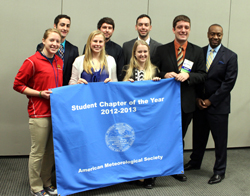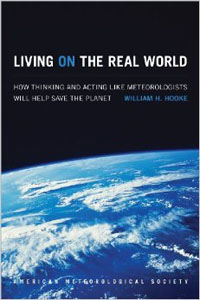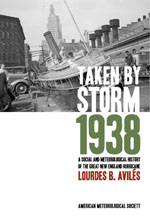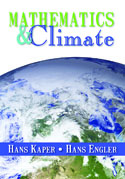In 1959 the AMS published a tome that became the touchstone document for a generation. The Glossary of Meteorology served its purpose well. So well that a 41-member editorial board and over 300 labored for five years to ensure the quality of the expanded, refreshed second edition of that volume…in 2000.
A lot happened in the meantime in the atmospheric sciences, largely because this community emphatically does not update itself solely on 41-year cycles.
Quite the contrary. There’s this thing called the Annual Meeting, for example. Refreshing our knowledge, contacts, perspectives, and priorities is what an AMS Annual Meeting is all about. If you peruse the program this week, you’ll find that practically every session has some abstract or title using the word “update.”
None of these presentations approaches updates with more earnestness than in the world of forecasting, where the pace of update has earned the phrase, “rapid refresh.” That would be RAP, in the parlance of the National Centers for Environmental Prediction: the 13-km resolution, hourly-updated mesoscale system so useful in convective forecasting, energy load prediction, and aviation products, among other things.
This week is a good opportunity to rapidly update your understanding of what’s going on with the newest edition of the RAP (version 2) and the nested 3-km rapid refreshing “High Resolution Rapid Refresh” model nested within it. HRRR is getting implemented at NCEP this year. Soon to follow are cloud microphysics enhancements and more. Eventually the rapid refresh pace will enter the world of ensembles, too. For more details get over to Room C203 today (Tuesday) at 2:45 PM to hear Stephen Weygandt et al. and then to the Georgia Ballroom 2 Wednesday at 11:15 AM to hear Stan Benjamin et al, and then again Room C203 for Patrick Hoffman et al.’s presentation on Thursday.
It seems only appropriate, then, to give credit to the Glossary for following the forecasters’ lead into the realm of rapid refresh. We no longer need wait 41 years for an update in defining the core terminology of scientific discourse. The Glossary has moved to the Web. Under the pioneering editorship of Mary Cairns, it takes about 50 days on average to peer review new definitions and terms. Then bingo, the word is officially published.
This week, in fact, while RAP is working on its updates, the Glossary came out with one of its own. The word of the month—or at least in January—was the “polar vortex.” Here’s a peak at what “polar vortex” meant in 1959:
polar vortex–(Also called polar cyclone, polar low, circumpolar whirl.) The large-scale cyclonic circulation in the middle and upper troposphere centered generally in the polar regions. Specifically, the vortex has two centers in the mean, one near Baffin Island and another over northeast Siberia. The associated cyclonic wind system comprises the westerlies of middle latitudes.
As it turns out, observations were already showing that the polar vortex was not merely a stratospheric phenomenon. This was one of the major changes incorporated in the 2000 edition. But during the endless media mangling of the polar vortex during the recent cold snaps and snows, experts discussing the terminology found some problems with the way the second edition had formulated the definition. So…a proposal for a change was submitted to chief editor Cairns. Within a few weeks, the proposal was peer reviewed and resulted in a new definition posted 30 January 2014.
Cairns tells us the new definition removes an inaccuracy and was updated to eliminate ambiguity and define seasonal characteristics of the vortex evolution. There is also now new language specifically addressing a subdefinition for the “polar stratospheric vortex.” It reads:
A planetary-scale mid- to high-latitude circumpolar cyclonic circulation, extending from the middle troposphere to the stratosphere. The Northern Hemisphere vortex often features two centers—one near Baffin Island and the other over northeast Siberia—with analogous circumpolar asymmetry atypical in the Southern Hemisphere. The westerly airflow is largely a manifestation of the thermal wind above the polar frontal zone of middle and subpolar latitudes. The vortex is strongest during the winter in the upper troposphere and stratosphere when the pole-to-equator temperature gradient is strongest. The stratosphere component of the circulation may be referred to separately as the “polar stratospheric vortex.” In summer, the strongest westerly circulation is largely confined to the troposphere, and the polar stratospheric vortex reverses in the upper stratosphere because of solar heating during the polar day.
But enough with the polar vortex, right? Back to our own ongoing rapid refresh here in Atlanta.






